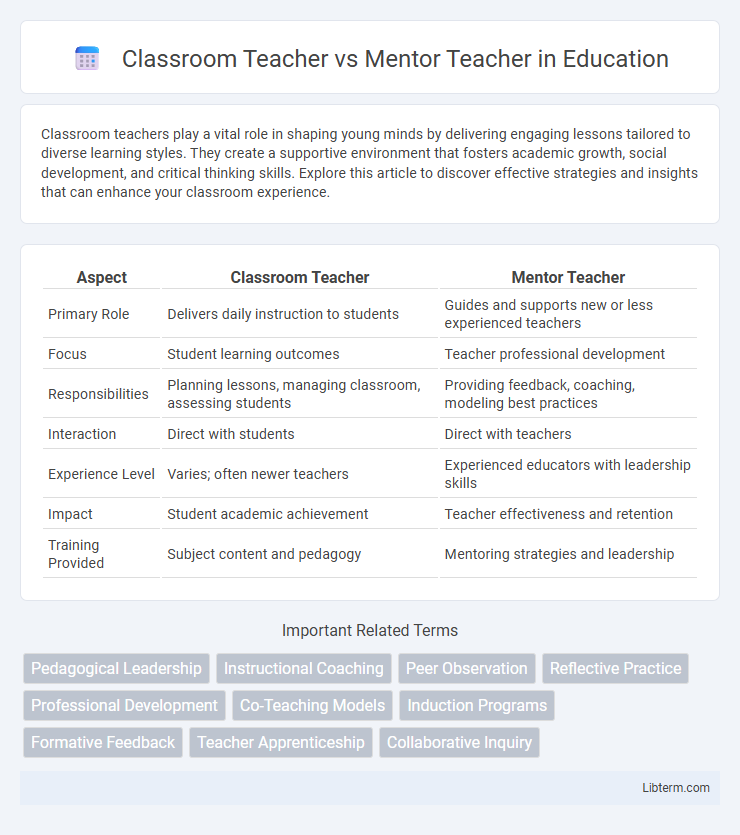Classroom teachers play a vital role in shaping young minds by delivering engaging lessons tailored to diverse learning styles. They create a supportive environment that fosters academic growth, social development, and critical thinking skills. Explore this article to discover effective strategies and insights that can enhance your classroom experience.
Table of Comparison
| Aspect | Classroom Teacher | Mentor Teacher |
|---|---|---|
| Primary Role | Delivers daily instruction to students | Guides and supports new or less experienced teachers |
| Focus | Student learning outcomes | Teacher professional development |
| Responsibilities | Planning lessons, managing classroom, assessing students | Providing feedback, coaching, modeling best practices |
| Interaction | Direct with students | Direct with teachers |
| Experience Level | Varies; often newer teachers | Experienced educators with leadership skills |
| Impact | Student academic achievement | Teacher effectiveness and retention |
| Training Provided | Subject content and pedagogy | Mentoring strategies and leadership |
Defining the Roles: Classroom Teacher vs Mentor Teacher
Classroom teachers are responsible for delivering daily instruction, managing student behavior, and assessing learning outcomes, directly influencing student achievement in their specific subject areas. Mentor teachers provide guidance, support, and professional development to novice or struggling teachers, fostering their instructional skills and classroom management techniques. The distinct roles emphasize that classroom teachers focus on student learning, while mentor teachers prioritize teacher growth and mentoring effectiveness.
Core Responsibilities of Classroom Teachers
Classroom teachers primarily focus on delivering curriculum content, managing student behavior, and assessing academic progress to ensure effective learning outcomes. They create lesson plans aligned with educational standards, foster a positive classroom environment, and provide individualized support to meet diverse student needs. These core responsibilities distinguish classroom teachers from mentor teachers, who concentrate on guiding and supporting professional development for fellow educators.
Key Functions of Mentor Teachers
Mentor teachers play a crucial role in guiding novice educators by providing targeted instructional support, fostering reflective practices, and facilitating professional development. They model effective teaching strategies, offer constructive feedback, and help mentees navigate classroom management and curriculum implementation. Unlike classroom teachers who primarily focus on delivering lessons, mentor teachers specialize in nurturing teaching skills and promoting continuous growth within educational environments.
Experience and Qualifications: Who Are They?
Classroom teachers typically hold a valid teaching license and possess foundational experience in managing diverse student needs within a classroom setting. Mentor teachers often have advanced certifications, extensive classroom experience, and specialized training in coaching and professional development to support novice educators. The depth of experience and higher qualifications enable mentor teachers to guide instructional strategies and foster teacher growth effectively.
Impact on Student Learning Outcomes
Classroom teachers directly influence student learning outcomes through daily instruction, curriculum delivery, and assessment strategies tailored to student needs. Mentor teachers enhance these outcomes indirectly by providing guidance, professional development, and support to classroom teachers, improving teaching effectiveness and classroom management. Research shows that schools with strong mentor programs report higher student achievement and improved teacher retention rates.
Supporting Professional Development
Classroom teachers deliver direct instruction and facilitate student learning, while mentor teachers play a pivotal role in supporting professional development through guidance, feedback, and modeling best practices. Mentor teachers provide targeted coaching to enhance instructional strategies, classroom management, and reflective practices, fostering continuous growth. Structured mentorship programs contribute to improved teacher efficacy, increased retention rates, and elevated student outcomes.
Collaboration and Peer Support Dynamics
Classroom teachers and mentor teachers engage in collaboration by exchanging instructional strategies, fostering a growth-oriented environment that enhances teaching efficacy. Peer support dynamics thrive as mentor teachers provide guidance, feedback, and emotional support, facilitating professional development and confidence in classroom teachers. This reciprocal partnership cultivates a culture of continuous learning and shared expertise within educational settings.
Challenges Faced in Each Role
Classroom teachers encounter challenges such as managing diverse student needs, maintaining discipline, and delivering curriculum effectively within limited time. Mentor teachers face unique obstacles including balancing mentorship duties with their teaching load, providing constructive feedback to novice teachers, and adapting support strategies to varied teaching styles. Both roles demand strong communication skills and adaptability to foster student and teacher growth in dynamic educational environments.
Benefits of Having Both in Schools
Classroom teachers deliver daily instruction and manage student learning, while mentor teachers provide guidance, professional development, and support for less experienced educators. Combining both roles enhances student achievement by ensuring effective teaching strategies alongside continuous teacher growth and morale improvement. Schools benefit from a collaborative environment that promotes instructional quality and fosters professional expertise across the faculty.
Choosing the Right Path: Which Role Suits You?
Classroom teachers focus on delivering curriculum and managing daily student learning, while mentor teachers guide and support novice educators in professional development and instructional strategies. Choosing the right path depends on your passion for direct student interaction versus a desire to influence teaching practices and foster teacher growth. Evaluating your strengths in leadership, communication, and instructional expertise can help determine whether you thrive in the classroom or as a mentor.
Classroom Teacher Infographic

 libterm.com
libterm.com